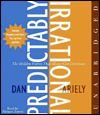 Predictably Irrational: The Hidden Forces that Shape our Decisions
Predictably Irrational: The Hidden Forces that Shape our Decisions
By Dan Ariely
Harper Collins Books, 2008
I have been reading a series of books by psychologists, doctors and economists this winter and spring about decision-making, toward a goal of making better decisions — or being less likely to make bad ones — in my role as a college president. The other titles include Malcolm Gladwell’s Blink, Daniel Gilbert’s Stumbling on Happiness, Freakonomics by Steven J. Levitt and Stephen J. Dubner, and How Doctors Think by Jerome Groopman. (I already have the next one in my sights: The Wisdom of Crowds by James Surowiecki.)
Predictably Irrational is a terrific book and a good read. I recommend it to you. Ariely is a behavioral economist, and he argues that “we are all far less rational in our decision-making than standard economic theory assumes.” Moreover, he believes that “our irrational behaviors are neither random nor senseless — they are systematic and predictable” (p. 239). He accuses standard economics of operating from a theory of how humans should behave, whereas behavioral economics draws its conclusions from studies of how people actually do behave.
Take anchoring, for example. (Anchoring, incidentally, is also discussed in a very interesting chapter of How Doctors Think in which Groopman describes it as a cognitive process that leads some doctors to make mistakes in diagnosis.) Ariely compares anchoring to imprinting, the process by which a baby gosling, upon breaking out of the egg, forms an attachment to the first thing it sees. In one study he asked his students to write down the last two digits of their social security number as a dollar amount (i.e., 23 would equal $23) and then invited them to bid on items in an auction. Students with social security numbers in the high digits were willing to bid the most for the auction items, while those with the lowest were willing to bid the least. The students imprinted, or anchored, on those numbers. Ariely then offers an compelling analysis of the price many Americans are now willing to pay for a cup of brewed coffee, describing the internal process by which we move our anchor from the price of Dunkin Donuts coffee to the price of Starbucks coffee. That, in turn, leads to an argument that we must rethink our notion of how supply and demand work. Ariely argues that our willingness to pay (demand) has to be understood in the context of a complex set of internal processes, like anchoring, such that it might be the market price itself that influences demand, rather than the other way around.
There are many other chapters in the book with similar insights. The most relevant for a liberal arts college, I think, is Chapter 4: “The Cost of Social Norms.” Ariely wants to distinguish between two separate realms, which all of us occupy simultaneously: the realm of market norms and the realm of social norms. As long as we keep them separate, we have clear markers about how to evaluate other people, or entities, and their actions. We don’t expect our bank to be generous and forgiving when we overdraw our checking account: we expect to pay a fee. Similarly, we don’t expect our parents to present us with a bill after dinner at home, nor would we bill them for going over to their house and moving a couch. This is why a few years ago AARP could get lawyers to volunteer free services for needy clients but could not persuade them to offer those services for a reduced fee of $30 an hour. Free legal services offered as a volunteer are governed by social norms; but once a fee enters the equation, market norms governed, and lawyers weren’t willing to work for that rate. Ariely points out that one direction corporations and other entities have taken is to attempt to create “social norms” around market relationships by creating a sense of family in the workplace or suggesting that a business relationship is like a family relationship. This might work well to attract customers, or to attract employees, but when the corporation reverts to exclusively market norms (outsourcing jobs, cutting pensions and benefits to control costs, etc.), the attempt to conflate these two realms falters, and the backlash is severe. St. Olaf regularly describes itself as a family and talks about its sense of community, and those terms extend beyond the campus to include parents, grandparents, and alumni. Indeed, I just recently wrote a letter to the parents of members of the Class of 2012 that began, “Welcome to the St. Olaf family.” But in truth we have not only social norm relationships but also market relationships with students and their families who pay tuition and fees, and it may be that we have not given careful enough thought to the extent to which we are confusing others, and ourselves, by the way we talk about our relationships in the context of how we behave toward members of our “family.”
Ariely’s book is optimistic. He points out our many foibles and irrationalities not to show how smart he is (though he does accomplish that as well), but rather to show how we can avoid making mistakes because of these traits we have (or as he would put it, because of the way our brains are wired). Thus, at the end of the chapter on anchoring he suggests ways we can avoid being trapped into, say, an unwise purchase by marketing forces. At the end of the chapter on social norms he offers good advice to employers about how to manage those two realms. In this respect his book ends better than Daniel Gilbert’s Stumbling on Happiness, which also points out how irrationalities pose an obstacle to happiness but which gives us much less direction in how to avoid them.
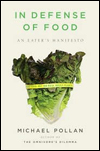 In Defense of Food: An Eater’s Manifesto
In Defense of Food: An Eater’s Manifesto
By Michael Pollan
The Penguin Press, 2008
This book was a gift from my wife, Priscilla Paton, who always reads interesting books. It’s by the author of The Omnivore’s Dilemma, which she’s reading now, and The Botany of Desire, a New York Times best seller. The author is a journalism professor at the University of California-Berkeley. Priscilla thought I might enjoy this book because I love good food (college presidents do a lot of business over meals), and I just had a physical during which the physician remarked that I might be enjoying good food a little too much.
Here’s the message of this book in seven simple words: “Eat Food. Not Too Much. Mostly Plants.” This is great advice. If we all followed it scrupulously, we’d be healthier. What exactly do these seven words mean? This is a 200-page book. If you want the executive summary, read the last two chapters, which spell out the conclusions reached by the previous 160 pages. Here are some of them: avoid food products containing more than five ingredients or ingredients that are unfamiliar, unpronounceable, or include high-fructose corn syrup. Shop the peripheries of the supermarket and stay out of the middle (processed foods tend to occupy the center aisles of the store, while produce, meats, and dairy tend to line the walls). Shop elsewhere than the supermarket, such as at farmers’ markets or CSAs (community supported agriculture). Eat mostly plants, especially leaves (as opposed to seeds).
Then there is a list of recommendations regarding how we eat, as opposed to what we eat. Among other things, the list recommends that you: do all your eating at a table; try not to eat alone; judge when you’ve had enough by how full you are, not by how much is left on the plate; and eat slowly.
These are all good suggestions, and I imagine most of us have heard them before. Since finishing this book, I’ve found myself looking with a more critical eye — and I thought I was already being pretty careful — at the list of ingredients on food packages. At lunch today, for example, I had some soup that I bought because it was a no fat, low sodium, Healthy Request® product, but I’d hate to tell you how many ingredients it had that were both unfamiliar and unpronounceable.
Nevertheless, I’m not sure what to make of this book. The first 160 pages are a diatribe against what Pollan calls “Nutritionism,” the proposition that “we should understand and engage with food and our bodies in terms of their nutritional and chemical constituents and requirements” (Pollan, quoting a sociologist of science named Gyorgy Scrinis (p. 27)). More simply, nutritionism thinks of foods as “essentially the sum of their nutrient parts” (p. 28). Nutritionism leads us to prefer processed foods to which we can add “good” nutrients and from which we can remove “bad” nutrients until we end up preferring processed foods to “real” food. Worse, Pollan argues, nutritionism serves the interests of manufacturers of processed foods, interposes “science” between us and whole foods, and takes away our delight in eating.
I had the interesting experience of consulting a nutritionist (see the reference to enjoying good food a little too much in paragraph one) at one of America’s most distinguished clinics during the same week that I read In Defense of Food. This nutritionist spoke favorably of a new pasta on the market that is enriched with various things that are good for you but don’t occur in regular pasta. This is exactly the kind of thing Pollan hates. My dilemma is who to believe: a nutritionist at a distinguished medical center or a journalism professor who sometimes, to be honest, comes off as a crank.
The right answer for me, as with most either-or questions, is probably “both.” Pollan’s last two chapters contain great suggestions about eating with care, but I don’t think I’ll re-read the early chapters.
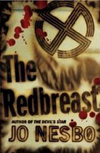 The Redbreast
The Redbreast
By Jo Nesbo
Published in Norway as Rødstrupe, 2000
Translated by Don Bartlett, 2006
Harper, an imprint of Harper Collins Publishers, 2006
Professor Margaret O’Leary of St. Olaf’s Norwegian Department is teaching a course this semester on Nordic crime fiction. This is one of the required texts, and I’m going to speak about it in the class later this semester. According to the book’s dust jacket, members of Norwegian book clubs in 2004 voted The Redbreast the “Best Norwegian Crime Novel Ever Written.” Since I haven’t read all of the other Norwegian detective novels (though I have read Nesbo’s other, later novel), I can’t comment on that claim, but I can confirm that this is an ambitious novel and a compelling narrative.
Crime fiction has always had its detractors who dismiss the genre as formulaic, cheap, superficial, fascistic, or just plain boring. Its most famous detractor, the American critic Edmund Wilson, summed up these objections in 1945 in an essay that borrowed for its title a character from an Agatha Christie novel, Who Cares Who Killed Roger Ackroyd? That about sums it up. Some defenders of crime fiction respond by arguing that this or that detective novel stands on its own merits as a great work of fiction. I don’t find that argument persuasive in most cases, but if I were to make that argument about a particular detective novel I would be tempted to make it about The Redbreast.
This novel features Harry Hole, a detective on the Oslo police force and a descendent of the Tough Guy tradition in crime fiction that we associate with Dashiell Hammett or Raymond Chandler: he lives alone, he drinks and smokes too much, he responds badly to structure and hierarchy, he will bend any rule, he’s foul-tempered, and he’s attracted by and attractive to beautiful women. At its core, the plot of the novel requires Harry to solve a crime — someone has smuggled into Norway a rare and powerful rifle that is most likely to be used for an assassination attempt, and he has to find out who has the rifle and to prevent the assassination. He does, and in doing so he also solves numerous other crimes that are causes of, or are caused by, the smuggled rifle.
But — and here’s where this novel gets ambitious — this crime plot is embedded in a sweeping historical fiction about Norway and World War II, especially about Norwegian men who went to the Eastern front and fought with the Germans and who, when they returned to Norway after the war, were tried and punished as traitors. Nesbo presents a complicated and human version of these men and the decisions they made during wartime, the effects of war upon them, and their subsequent lives. The narrative moves back and forth between events in the 1940s and Harry Hole’s investigation, which ends up involving many of these men and their families. The novel thus becomes a study of Norway’s experience of the war and the ways it constructed that history during the post-war years. Nesbo manages to engage this sweep of events and these complicated and emotional subjects without diluting the tension created by Harry Hole’s race against time to find the assassin and prevent an assassination.
The artistry of the novel is evident not only in the plotting but also in Nesbo’s use of the story of David and Bathsheba, which echoes both in the narrative of Norwegians on the Eastern front in the 1940s and in the contemporary Norwegian setting of the novel. The pattern of imagery in The Redbreast, particularly images related to birds, provides one of the sources of coherence and continuity to the broadly ranging narrative.
So, if you don’t care who killed Roger Ackroyd but you do care about depictions of contemporary Norway and explorations of its recent history, I predict that you will enjoy this novel. If you are a fan of the dark strain in Nordic crime fiction, this novel is a must.
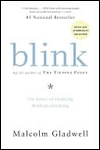 Blink: The Power of Thinking Without Thinking
Blink: The Power of Thinking Without Thinking
By Malcolm Gladwell
Little, Brown and Company, 2005
I had read Malcolm Gladwell’s many fine articles in The New Yorker before I read Blink, and I had heard readers talk about the book, so I thought I knew what to expect when I opened it. I was wrong.
This book does not argue, despite what people will tell you, that snap decisions are the right ones, or that intuition is more likely to be right than careful deliberation, or that you can know what to do in the blink of an eye. Its short title, Blink, without the subtitle, The Power of Thinking Without Thinking, encourages such a reading.
Quite to the contrary, however, Blink is actually a book about how not to over-think problems. It assumes that you have a deep knowledge of a subject. Beginning with that assumption, it shows how you can keep from being weighted down, misdirected or confused by details and, thus, make a wrong decision. If you don’t know anything about a subject, a snap decision about it will be exactly what you would expect it to be: uninformed, superficial and most likely wrong. This is a book about something else: how to be able to see the forest despite the trees.
The story with which Blink begins illustrates Gladwell’s argument. The Getty Museum in California was offered an opportunity to purchase from an art dealer a 6th-century B.C. marble statue. The Museum approached the offer with appropriate skepticism, studying it for 14 months, even to the extent of hiring a geologist to examine the stone from which the statue was made to verify its antiquity and to see whether it was consistent with the geology of the site where it was presumably found. Persuaded, finally, by X-rays, mass spectrometry, an electron microprobe and other tests, the museum purchased the statue. When the new purchase was shown to a distinguished art historian and an expert on Greek sculpture, she immediately knew it was a fraud. She and a number of other art historians knew in seconds what 14 months of due diligence had failed to recognize. As Gladwell says, “Blink is a book about those … two seconds” (p. 8).
The art historians who immediately knew something was wrong with the statue were the world’s foremost authorities on Greek statuary. They had seen countless Greek statues, some coming out of the ground, some in museums. They had touched and handled them. They had a deep knowledge of the subject. When they saw the statue, in a quick, holistic judgment it looked wrong to them. A geologist looking at the results of an X-ray only saw the results of the X-ray. Gladwell calls the quick assessment of the statue by art historians a “thin slice” of experience. He argues that thin slices can contain vast amounts of information and that they do indeed constitute the basis for good decisions.
Blink offers other examples of this same phenomenon, but it is more than a collection of anecdotes. For example, in a fascinating chapter about war games, it shows how a military general created a “structure for spontaneity” that enabled him and his team to outmaneuver an opposition that had a vastly superior capability in technology and was overwhelmed with data.
This is a good book for people with leadership responsibilities because of its helpful focus on efficient, holistic thinking, on the big picture, on what matters. I recommend it.
 Before the Frost
Before the Frost
By Henning Mankell
Published in Sweden as Innan frosten, 2002
Translated by Ebba Segerberg, 2004
Vintage Books, an imprint of Harper Collins, 2006
My friend and colleague at St. Olaf Janet Kringen Thompson, who also tends to be beguiled by crime fiction, loaned me this novel. I was delighted to read another work by Henning Mankell. The Scandinavians are producing terrific crime fiction these days between Mankell, Jo Nesbo (see my thoughts on Devil’s Star ), and Anne Holt (see my thoughts on Punishment). I am by no means expert in Scandinavian literature; perhaps there are other writers in this tradition that I have not discovered yet.
Before the Frost takes on the subject of religious mania. From its opening scene in the ruins of Jim Jones’s suicidal sect in Guyana to its closing scene in a churchyard near Skurup, Sweden, this novel depicts the murderous path of a man who has persuaded himself, and a band of followers, that God has appointed him to administer justice to sinners. This involves, among other things, re-writing the Bible, and a major clue in the police investigation here is a Bible in which one of the suspects uses interlinear annotations to reverse the meaning of scripture. In a nicely conceived passage that gets at the heart of this theme, a university theologian, examining this Bible, points out to the police that Romans 7:19: “The good that I wish to do, I do not; but the evil that I do not wish to do, I do” has become, in this devil’s scripture, “The evil that I wish to do, I do; but the good that I do not wish to do, I do not do.”
But this novel is not just about a murderous religious maniac and the police investigation that aborts a terrorist plot. Inspector Kurt Wallander’s daughter Linda has finished her training course at the Police Academy and is preparing to join the same force where her father works. The personal and professional dynamics of this relationship play a central role in Before the Frost, which is in many ways a coming of age novel about Linda Wallander. Another, deeply disturbed, father-daughter relationship in this novel, between the central figure in the crime and his own daughter—one of Linda’s childhood friends—gives depth and contrast to the father-daughter dynamic between the Wallanders. It’s very well done.
The Scandinavian crime writers are nothing, if not bleak, but if you are prepared for a dose of darkness and you relish an exploration of the inner life as much as solving crimes, then you will enjoy Before the Frost.
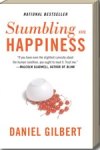 Stumbling on Happiness
Stumbling on Happiness
By Daniel Gilbert
Vintage Books, a Division of Random House, Inc., 2005
This winter I’ve been reading books that, from a variety of methodologies and perspectives, analyze how we humans make decisions. More specifically, these books have studied what kinds of cognitive and emotional errors lead us to make bad decisions. How Doctors Think was a study in how to know what you don’t know; Freakonomics argued that you will make better decisions if you know what to measure and how to measure it; and Blink, by Malcolm Gladwell, argues that you can succumb to “paralysis by analysis” if you forget, in certain situations, to look holistically at data rather than tearing into, and getting lost in, a forest of details.
Stumbling on Happiness, by the Harvard psychologist Daniel Gilbert, argues that because of the way our minds work we tend to misremember the past, misperceive the present and, misimagine the future. Because our understanding of ourselves is based on wrong information about what has happened to us and is happening to us, we are at a disadvantage in making important decisions about our lives. This is not a gloomy book, however. Gilbert’s goal is to show us how our minds work so that we can overcome these tendencies, understand our situations more clearly, and be more happy. He believes that if there is no sure path to happiness, it is better to understand what makes us stumble on that path than simply to wander, lost in error and confusion.
So what is it about the way our minds work that can lead us to such error? A central mental operation that confuses us Gilbert calls “filling in.” “The elaborate tapestry of our experience is not stored in memory—at least not in its entirety,” Gilbert argues (p. 87). Thus, when we want to remember something, our brains “reweave the tapestry by fabricating—not by actually retrieving—the bulk of the information that we experience as memory” (p. 87.) As countless researchers have demonstrated, “the act of memory involves ‘filling in’ details that were not actually stored; and … we generally cannot tell when we are doing this …” (p. 88). This same act of “filling in” characterizes our perception of the present, too, so that what we believe we see, read, and hear may often contain material that the brain imported, without our knowledge, to fill a gap in perception. When we try to imagine the future, because our imaginations “cannot easily transcend the boundaries of the present” (p. 138), our image of the future tends to be colored by the present moment. If you’ve had a terrible day, researchers have found, you have a difficult time imagining having a good time in the future, even when you’re imagining an activity you like to do.
Gilbert’s work, incidentally, reminds me very much of my favorite writer, Samuel Johnson who, in the eighteenth century, wrote a series of brilliant and deeply felt essays, the Rambler essays, on how the two great human emotions of fear — which repels us from things — and hope — which draws us towards things — can trap us in a vicious cycle of attraction and repulsion, of past and future, that prevents us from finding happiness in the present.
What does Gilbert suggest we do, given his analysis? We can’t change the way our minds work, and, indeed, we shouldn’t. But it is important that we understand how our minds work so that, to the extent we are able, we can recognize when memory is “filling in” and creating a fictitious past, or our feelings about dinner with friends tomorrow are being colored by the rotten day we had today. Gilbert argues that “our experience of the world — how we see it, remember it, and imagine it — is a mixture of stark reality and comforting illusion. We can’t spare either” (p. 176). Understanding that dynamic can help us preserve a balanced view of ourselves and our experience. Our minds may fill in details from our present when we try to imagine the future, but our ability to imagine the future at all enables us to “learn from our mistakes without making them and to evaluate actions without taking them” (p. 263).
The prose style of Stumbling on Happiness is remarkable. One reviewer described it as a cross between Malcolm Gladwell and David Sedaris. I would describe it as, over time, annoying. Gilbert never misses an opportunity to be witty, with the result that this book is genuinely funny at some times but at other times just plain tiresome. Samuel Johnson described the pun, for Shakespeare, as the “fatal Cleopatra for which he lost the world, and was content to lose it” (Johnson wasn’t a fan of puns). Gilbert’s fatal Cleopatra is the wry witticism. It’s like spending the whole day with a stand-up comedian who never stops cracking jokes. But this is nevertheless a deep book on an important subject, and I recommend it to you.
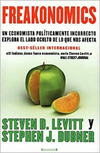 Freakonomics: A Rogue Economist Explores the Hidden Side of Everything
Freakonomics: A Rogue Economist Explores the Hidden Side of Everything
By Steven J. Levitt and Stephen J. Dubner
William Morrow, an imprint of Harper Collins, 2005
The authors of this book, an economist from the University of Chicago and a writer for the New York Times, coined the term “Freakonomics” to describe their purpose in this book: to employ “the best analytical tools that economics can offer . . . to follow whatever freakish curiosities may occur to us” (p. 14). In their view, “since the science of economics is primarily a set of tools, as opposed to a subject matter, then no subject, however offbeat, need be beyond its reach” (p. 14). If you are detecting a certain amount of hubris in their tone here, and in the claim of the book to explore the “hidden side of everything,” you’re not far wrong. But then, quite frankly, a certain amount of hubris often seems to come with the territory when you’re dealing with economists.
This book begins by articulating its key assumptions: “Incentives are the cornerstone of modern life”; “The conventional wisdom is often wrong”; “Dramatic effects often have distant, even subtle, causes”; “‘Experts’ … use their informational advantage to serve their own agendas”; and “Knowing what to measure and how to measure it makes a complicated world much less so” (pp. 13-14). The first and last of these assumptions are, of course, the key ones. The authors believe that you can understand human behavior by discerning the personal advantage that accrues to an individual from behaving one way versus the other. Parents at an Israeli day care center will not be discouraged from picking their children up late if the fine is three dollars, because whatever they are doing to make them late is worth more to them than the three dollars. Moreover, when the day care center institutes a three dollar charge for late pick-ups, the number of parents arriving late actually increases because not only is the sum nominal but now that they are paying for this service they don’t feel guilty about leaving their children longer. In online dating, “for men, being short is a big disadvantage (which is probably why so many lie about it), but weight doesn’t much matter. For women, being overweight is deadly (which is probably why they lie)” (p. 83). You get the picture.
The second assumption follows from the first. If our behavior is driven by incentives, then to understand that behavior you must figure out what aspect of it that can be measured will reveal the true nature of the incentives driving us. As the authors say early on in the book, “Morality … represents the way that people would like the world to work — whereas economics represents how it actually does work” (p. 13). For example, the reason why parents name their children in a certain way can be understood from studying a vast database of children’s names in California that is correlated against information about the parents’ socioeconomic status. High-status names tend to be adopted by low-status parents, causing high-status parents to choose different names that are then adopted by low-status parents, and so on. (Incidentally, if the authors are correct, there are going to be some children with pretty silly names coming our way soon.)
If you buy these key assumptions you will find this book deeply insightful, and if you don’t buy these assumptions you will have lots of chances to push back against the arguments. In either case, I predict that you will find it surprising and funny. The authors are good at posing outlandish questions to introduce their analysis of a particular issue: what do sumo wrestlers and teachers in the Chicago public schools have in common? What did a pregnant, single mother in Dallas in 1970 have to do with the drop in crime all across America in the 1990s? Why do crack dealers live with their moms? (The answers, though interesting, are never quite as astounding as the questions might lead you to expect.)
For me the great value of the book is its insistence on a rigorous critique of received wisdom and its impatience with self-serving arguments, moral posturing, and lazy thinking. The authors rightly emphasize the role technology is playing in providing each of us the information to do this analysis — the price of term life insurance fell dramatically in America when the Internet made it possible to easily compare rates, for example — but it’s up to us to have the energy to ask the questions and the discernment to find the right questions to ask. Whether you believe that all of our behavior is incentive-driven or not, this book’s insistence on persistent questioning is a good thing.
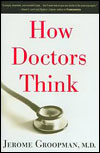 How Doctors Think
How Doctors Think
By Jerome Groopman, M.D.
Houghton Mifflin, 2007
This is a fascinating book, and I urge you to read it, even if you aren’t particularly interested in doctors or medicine. A better title for it might have been “How To Reduce the Likelihood that You Will Make A Big Mistake” or “Some Help in Knowing What You Don’t Know.” That’s really what this book is about: how our cognitive processes and our feelings can lead us to draw incorrect conclusions from data. This book analyzes that problem through the lens of clinicians making diagnoses in hospitals and doctors’ offices, but it could just as well have been about how CEOs or college presidents think. You’d have different contexts but the same types of errors to study.
Groopman makes extensive use of research done by cognitive psychologists, who study this sort of thing. It turns out there are names for many of the common mistakes in our thinking. For example, there is the availability error: “the tendency to judge the likelihood of an event by the ease with which relevant examples come to mind” (p. 64). (This type of error has also been used, incidentally, by economists to explain irrational behavior in the marketplace.) Groopman uses the example of a clinician who misdiagnosed aspirin toxicity in a woman because it had some of the same symptoms of subclinical pneumonia, and the doctor had seen numerous cases of that in other patients recently. Or there’s “anchoring”: “a shortcut in thinking where a person doesn’t consider multiple possibilities but quickly and firmly latches on to a single one” (p. 65). Another, which follows anchoring, is “confirmation bias,” which is “selectively accepting or ignoring information” (p. 65). If you latch too early on to a diagnosis (that’s anchoring), then you are likely to pay attention to the symptoms that confirm that diagnosis and to ignore those that, inconveniently, do not (that’s confirmation bias). There are many examples like this in the book. Not all of them are cognitive errors, by the way. Some are what you might call “affective errors,” such as when a doctors sympathizes so much with a patient’s suffering that he decides not to order an invasive test that, if ordered, might have aided the diagnosis.
I am often asked, “What keeps you up at night?” This is an important question that might be rephrased as “As the president of St. Olaf, what worries you the most?” The truth is that most nights I sleep soundly, but if you were to drive by the president’s house in the wee hours of the morning and see the lights on in my study, it would be because I’m worrying about how I can know what I don’t know. What evidence might I be unconsciously ignoring as I think about the college and its future? Am I unconsciously committing the kinds of cognitive and affective errors Groopman describes in his book? How can I avoid them? The short answer is probably that you can’t avoid them entirely, but you can certainly guard against them by, among other things, reading books like this one.
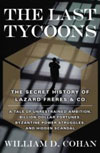 The Last Tycoons: The Secret History of Lazard Fréres & Co.
The Last Tycoons: The Secret History of Lazard Fréres & Co.
By William D. Cohen
Doubleday, 2007
I won’t lie to you: at 742 pages, this book requires a real commitment. And despite its subtitle — “A Tale of Unrestrained Ambition, Billion-Dollar Fortunes, Byzantine Power Struggles, and Hidden Scandal” — it’s not exactly a page-turner. Why would a mild-mannered college president start, and then persevere to the end of, this book? I read it for several reasons. First, it was recommended to me by an Ole who is in the investment banking business. Second, I wasn’t entirely sure what investment banks do, and I thought it would be good to know. Third, the history of Lazard is intertwined with some memorable moments in recent American history, including the Watergate scandal, the rescue of New York City from bankruptcy in the 1980s, and the flood of mergers and acquisitions that reshaped the landscape of corporate America in recent years.
Finally, though, the most compelling aspect of this book for me was Cohen’s analysis of the philosophy of governance at Lazard and his study of how that shaped, for better or worse, the leadership at the firm. For most of its history, Lazard operated, in the words of one of its partners, not as a partnership but rather as a “sole proprietorship with fancy profit sharing.” One person had the unilateral ability to determine who would be a partner and to set compensation for the partners. Lacking any form of transparent corporate governance, Lazard became, in Cohen’s account, a collection of fiercely independent individuals who were highly motivated by their individual goals and wealth ambitions but only loosely held together by an all-powerful leader. It relied on the “Great Man” model, by which clients would come to the firm because of the pre-eminent ability and reputation of its partners (Felix Rohatyn was the classic example of this model in operation) rather than, for example, by the firm’s ability to bring together resources from across its operations to assist a client. The story told in this book is essentially the story of how Lazard flourished — or not — for most of its history as a result of this governance model.
The analysis of Lazard’s leadership model in this book is surprisingly relevant to colleges and universities. There, too, you have very smart, fiercely independent individuals, many of whom have been trained in a highly individualistic research environment, and many of whom have something equivalent to the ownership stake of partners in a business through the awarding of tenure. Colleges and universities don’t have all-powerful leaders of the kind Lazard had, but I think it would be fair to say that they nevertheless experience the same tensions between the aspirations and prerogatives of individuals versus the needs of the organization as a whole. It’s the same set of leadership challenges.
So, on a snowy Minnesota day like the one outside my window as I write this, a person with a warm fire to sit by, time on her hands, and a certain amount of perseverance, might like to pick up this book. It raises important issues.
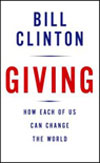 Giving. How Each of Us Can Change the World
Giving. How Each of Us Can Change the World
By Bill Clinton
Alfred A. Knopf, 2007)
The most interesting book I read last year was “Who Really Cares” by Arthur C. Brooks, a scholarly study of philanthropy in America that comes to some surprising conclusions. So, when I saw Bill Clinton’s book at the Northfield Library, I was eager to read another book on the subject. “Giving” isn’t as substantive a book as “Who Really Cares,” but then it isn’t trying to do the same thing.
Clinton’s book is an exhortation, not a study. It argues that “almost everyone — regardless of income, available time, age, and skills — can do something useful for others and, in the process, strengthen the fabric of our shared humanity.” The purpose of this book, then, is to provide examples, encouragement, and inspiration for readers who are looking for ways to give. It’s divided into chapters on giving money, giving time, giving things, and giving skills. These chapters are full of inspirational examples of ways others, rich and poor, young and old, have found to give. Clinton also provides resources for people looking for particular avenues for their philanthropy, one of which I plan to take advantage of myself.
But this is only half the book. The following chapters take a more macro look at giving, and they were the most interesting to me, in particular those on “Gifts of Reconciliation and New Beginnings,” “Giving to Good Ideas,” and “Organizing Markets for the Public Good.” I recommend these chapters in particular for the reader who is looking beyond his or her own personal philanthropy to ways that our world could be organized differently to promote the general welfare.
I realize that not everyone admires the former president, and those who don’t will find some passages in this book irritating, especially those where Clinton comes off as self-serving or detours into a defense of people and policies from his administration.
Overall, though, the aims of this book are worthy and certainly timely: to inspire philanthropy and to provide resources for those who want to give. I warrant that every reader will profit from this book in thinking about his or her own philanthropy.
I did.
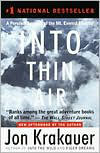 Into Thin Air: A Personal Account of the Everest Disaster
Into Thin Air: A Personal Account of the Everest Disaster
By Jon Krakauer
First published by Villard Books, 1997
Anchor Books paperback edition, 1998
This is a thrilling adventure book that tells the story, from the point of view of one of the climbers, of an ascent of Mount Everest in 1996 that ended disastrously in the loss of many of the members of the party. Apart from the excitement and horror of the story, I found myself most interested in thinking about exactly what the book was aiming to do.
Krakauer calls it a “Personal Account,” and the key word there, of course, is “Personal.” To the extent that any of us really knows why we do what we do, the narrator is able to explain why he goes on this trip, why he makes the choices he does at any given point, and how he feels about what is happening. On the other hand, one of the effects of high altitude is impairment of the cognitive functions, so there are times in the narrative when the narrator was in no position to understand what was happening around him, and even after the events are over he sometimes has to depend for information on his memory distorted by altitude sickness. Furthermore, the narrator has to make inferences and assumptions about what motivated other characters in this story to behave as they did. Why did his expedition leader not abandon the ascent at his firm deadline for turning around? The narrator wasn’t there when that decision was made, and the trip leader died on the mountain, so we will never know. So, “Personal” here can also be read as “partial” or “incomplete” as, indeed, all personal narratives necessarily are.
You could also think of this book as an Apology, not in the modern sense of an expression of regret but in the older sense of a defense of one’s actions (think of Cardinal Newman’s great Apologia Pro Vita Sua in which he explained and defended his conversion from the Church of England to Catholicism). For, the fact of the matter is that the narrator was one of the few in his party to survive the ascent of Everest, and as he himself says in this book, choices that he made along the way may well have contributed to the fate met by others in his party. He admits to suffering from “survivor guilt,” and it appears that one of the purposes of the book is to expiate that guilt.
This is where it gets tricky. Krakauer offers his “Personal Account” as an honest, self-critical narrative of what happened on the mountain, but it struck me in the reading as having elements of the Apology as well. There’s nothing wrong with defending oneself, of course, but it’s better to acknowledge that purpose up front.
But that’s what’s interesting about this book. It is a compelling account, with complicated purposes, of an exciting and sad story told by one of the participants. I recommend it.
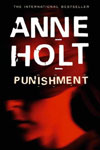 Punishment
Punishment
By Anne Holt
Trans. Kari Dickson
London: Sphere (published in Norwegian 2001; English translation published 2006)
This excellent crime novel was a gift from my friend Einar Vannebo, who directs the University of Oslo International Summer School, with which St. Olaf has a long and strong relationship. Einar gave me this book on the eve of my departure from a week in Oslo to return to America. It was the perfect gift for someone going on a long flight. I began it in Oslo and finished it somewhere over the Atlantic. I recommend it heartily.
In Punishment all of Norway is shaken by a series of abductions, and murders, of children. The children disappear, and then later their bodies are sent to their mothers with the message “Now you’ve got what you deserved.” Police Superintendent Adam Stubo is on the hunt for the killer, and he recruits Johanne Vik, an academic psychologist with a law degree, to help him. Both Stubo and Vik have tortured pasts. Stubo’s wife and daughter were killed in a freakish home accident, leaving him with a grandson. Vik is divorced, sharing custody of her daughter who, while clearly bright and sensitive, exhibits abnormal symptoms and behaviors that psychologists cannot diagnose. She was trained in the States as an FBI profiler, and something bad happened that is not revealed in this novel that brought her back to Norway and into a different career. You can see where this is headed: two unhappy single people with children they love coming together to hunt a serial child murderer. The hunt for the killer and the developing relationship between Stubo and Vik become one story.
This intricately plotted novel has an extraordinary ending, which I won’t give away. Its mood is dark, the plot is horrific, and the main characters stumble awkwardly toward both the solution to the crime and a new understanding of themselves. It’s a great read.
(If you’ve been to Oslo, you’ll enjoy the local color.)
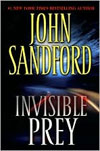 Invisible Prey
Invisible Prey
By John Sandford
G. P. Putnam’s and Sons, 2007
John Sandford, a Minnesota writer, is the author of one of the great series of detective novels currently underway: the Prey series. Invisible Prey is the seventeenth novel featuring Lucas Davenport, formerly of the Minneapolis police and now with the state Bureau of Criminal Apprehension. This novel has many of the features that make Sandford’s Prey novels so fun: lots of references to places in Minneapolis and St. Paul; new developments in the relationship between Lucas and his wife Weather, a plastic and reconstructive surgeon who once had to perform an emergency tracheotomy on him with a knife; further depth to the portraits of Lucas’ law enforcement colleagues; Sandford’s characteristic embedding of the pursuit of criminals in a cynical political environment; the “cop talk” between Lucas and his friends. This is the second Prey novel in which one of the Northfield colleges plays an important role. In a previous novel, Broken Prey, the victim of a particularly gruesome crime was a faculty member at St. Olaf, and there was a suspenseful search around Northfield that locals could easily follow with their knowledge of nearby roads. This time it’s Carleton that features in the plot. (I can’t say more without giving away too much about the ending.)
This wouldn’t be the book for those who abhor vulgar speech or plots that involve some nasty sex. But if you take those elements as part of the landscape in hard-boiled crime fiction, and if you like crime fiction, this is a great read.
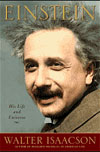 Einstein: His Life and Universe
Einstein: His Life and Universe
By Walter Isaacson
Simon and Schuster, 2007
My friend Professor Gary Stansell in the St. Olaf Religion department recommended this new biography of Einstein. I recommend it to you. At 551 pages, excluding the notes, it requires a commitment from the reader, but the commitment is worth it. To be quite honest I was less drawn to this biography by the sciencethough its interesting and importantthan I was by the world that shaped Einstein and that, in turn, he helped to shape. One key theme of the book is Einsteins rejection of nationalism, chauvinism, and authoritarianism that manifested itself early in his life and characterized his approach to learning, to science, and to politics. Another is Einsteins reputation for being emotionally distant to his family and friends. As Isaacson observes, Einstein was … good and flawed, and the greatest of his failings came in the realm of the personal (p. 518). Certainly, he was not a model husband or father, though he was apparently could be a warm and generous friend. Einsteins complex and changing attitude towards Judaism and his own Jewishness is a fascinating aspect of this narrative.
It turns out Einstein was an advocate for liberal learning. In a very amusing passage, Isaacson recounts a passing remark of Einstein that is relevant to us at St. Olaf. Apparently Thomas Edison disparaged American colleges as too theoretical. So, he devised the Edison test for job applicants that required applicants to demonstrate their practical knowledge by answering factual questions. The Governor of Massachusetts at the time, Channing Cox, was asked some of these questions. Here are the questions and his replies: Where does shellac come from? From a can. What is a monsoon? A funny-sounding word. Where do we get prunes. Breakfast. Reporters tried to get Einstein to take the Edison test, but he refused, saying, The value of a college education is not the learning of many facts but the training of the mind to think (p. 299). He was certainly correct.
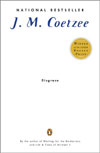 Disgrace
Disgrace
By J. M. Coetzee
First published 1999; Penguin Books, 2000
My wife, Priscilla Paton, brought this novel along on our vacation. Shes writing a book on humans and animals, a major theme of Disgrace. The book was there, so I read it, too.
This is a novel about many things: the tensions between men and women, children and parents, youth and age, whites and blacks in South Africa, humans and animals. Its about the academy, about predatory seduction, about violence—especially sexual violence—and about history. Coetzees challenge in this novel, it seems to me, is unifying these many themes. Perhaps because Im a white middle-aged male academic, I think that the unifying element in the novel is the story of the protagonist, a white middle-aged academic named Professor David Lurie. Lurie is having a mid-life crisis. He is uninterested in and uninteresting to his students and colleagues, and he has no passion for his discipline. His book manuscript has stalled. His marriage has failed. He finds sexual release through an escort service specializing in exotic (i.e. black) women. He responds to his mid-life crisis in the worst possible way: by seducing a student. Thrown out of his job, he is gradually stripped of all of the appurtenances of his middle-class life, his intellectual pretensions, his comforts and security. He goes to live with his daughter on a farm, where terrible things happen. Like King Lear, he is reduced to his elemental self. This is a grim novel, but it is written in beautifully spare and powerful prose. Reviewers have spoken of its tenderness. I dont see tenderness, but I admire Coetzees remorseless clarity.
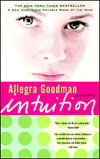 Intuition
Intuition
By Allegra Goodman
Dial Press, 2006
There is a funny blurb on the back cover of this novel by Maureen Corrigan, who reviews fiction for National Public Radio: Ive got a new comeback to those who dismiss contemporary fiction. Im just going to hit them over the head with Allegra Goodmans new novel, Intuition, and hope it knocks some sense and humility into them. I think Corrigan overstates the case, but I enthusiastically recommend this novel.
Intuition, set in a cancer research institute in Boston, takes the culture of scientific research as its topic. The main characters are the two Principal Investigators who run the lab and the various post-docs who do most of the work. One of the post-docs comes up with some remarkable experimental results which, if replicable, could potentially bring fame to him and his lab, vast grant dollars to the PIs, and—more to the pointhope for cancer victims. Are these results too good to be true? At what stage in the process of verifying them should they be publicized? What process of verification should be used, and who should do the verifying of those results? Can something be true because you so badly want it to be? How do youindeed can you?—separate pure motives from selfish ones when you throw love into the scientific mix? How can so many smart people behave like this?
This novels omniscient narrator spends time inside the heads of each of the characters, alternating from one to another without, like the narrator of Tom Jones to take a famous example, providing a meta-narrative that judges those characters. Readers are thus thrown back on their own resources to evaluate the characters as the narrative progresses. This is a good thing.
The narrative is compelling, the characters are complex, and the tone is judicious. Its a good read.
You must be logged in to post a comment.